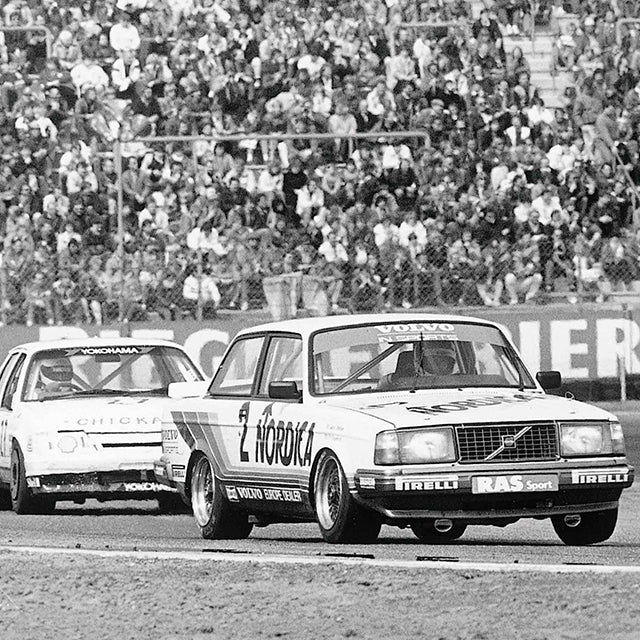Back in 2013, I launched my new career as an artist , and doing so, found the need for a suitable car with lots of load space. Although practicality was uncomfortably high on my list of boxes that needed ticking, things like; style, comfort, class, and “more than four cylinders” still took equal precedence! My eventual choice was the much-loved Volvo V70. Since, I’ve had the strangest feelings for Volvos start to run through me…and I know I’m not alone.
Growing up in the UK during the ’70s and ’80s, there was only everone estate car (or wagon, if you’re American), and that was the Volvo 240—quite possibly one of the least sporty cars ever to put rubber to tarmac. It was seen more as the ‘ultimate family machine’ as opposed to ‘ultimate driving machine’.
And it’sthis idea that fuels my new-found passion for all things Volvo 240. More often than not, I get photos of tastefully retro-modified 240s popping up in my Instagram feed, and as a result I have really learned to appreciate the car’s clean and honest design aesthetics.
So why is this new trend with modifiers rebuilding the brick spreading like Ikea stores? Well, I know that in the homeland, Swedish builders have—of course—long used the 240 as a base car, and there’s even an entire rally championship devoted to flinging bricks through the countryside, but where does this fascination for everyone else originate from?

It must surely go back to the European Touring Car Championship-winning 242 Turbo. If you werethinking I was going to say the TWR-built Volvo 850 T5s of British Touring Car fame, then you were almost right.
Those incredible carswere going to be the focus of this story—if it wasn’t for the Nordica-liveried 240 Turbo from the mid-eighties.
Light to dark blue stripes on a white car, with black window frames, is as safe a design solution as the cars themselves. This isn’t a dig at the design, in fact, far from it. You, like me, may have an unnatural obsession with blue stripes on a white background, mostly thanks to Suzuki’s GSXR and Scania Trucks—the fellow Swedish manufacturer had very similar stripes as an option during the same era.
Seeing these two passions come together was a guarantee that my creative eye would pop with excitement. The livery may be very straightforward and safe, but it was totally on trend for the ’80s—this being the ultimate decade for stripes on vehicles, graphics graced everything from hatchbacks to HGVs, no one could escape a stripe…or four.
To match the ’80’s graphics, the car sports some of my favourite, classic, ‘factory’ modifications: a chin spoiler, subtle rear decklid spoiler, lattice split-rim alloys, and a not-too-lowered suspension.


What a perfect inspiration for the growing legion of Volvo fans to draw from: a car that totally changes its image with such simple nips and tucks. The Swedes—along with the rest of Scandinavia—have always stuck to their own ‘design’ guns, and have consistently delivered superb design ethics throughout their manufacturing history.
Having a ski boot brand as a main sponsor—well that’s just the icing-on-the-lake! Actually, the various properties of the livery would sit well on an actual ’80s ski boot.
The 240 Turbo wasn’t all show either, it had equal success in terms of results, winning both the ETCC and DTM championships in 1985. The ‘flying brick’ would, rightly so, scare the competition as much as the 850 T5s did a decade later, and therefore deserves its place in speed icons history, it also answers my question on how awesome modified Volvos can become.

There is a dark side to this car—which only adds more kudos to the legend—andthat is its rule-breaking streak. The FISA rules allowed for special homologation models, and this is where it gets interesting: Volvo were reputed to have built 500 examples of the two door 240 Turbo Evo but the cars that actually got sold to customers did not exactly have any of the previously mentioned unique features, such as a bigger turbo, water injection, and so on. The story is that Volvo delivered the 500 cars to the USA—many fitted with desirable flathoods and a rear spoiler in the trunk—and 23 of the cars were in actual Evo specification and were inspected by FISA.
However, the other cars did not have the special equipment and were sold as regular 240 Turbo models. The 23 inspected cars were then supposedly sent back to Europe and turned into racing cars. These Evo models, I’m led to believe, are still somewhat of a mystery and highly sought after—if at all they even exist?
I, for one, like this naughty side of Volvo that only seems to come out on the track, and with the recent Polestar-based cars making waves, I’m glad they’re throwing ‘flying bricks’ our way again. Now, how long does one wait until you can retro-mod an old V70?


Images courtesy of Volvo Car Corporation




















































